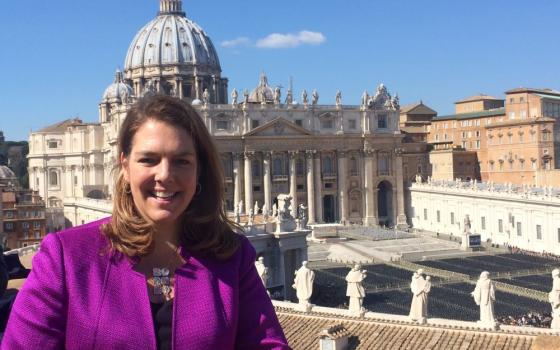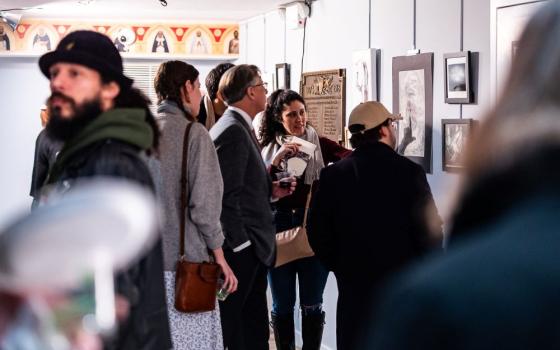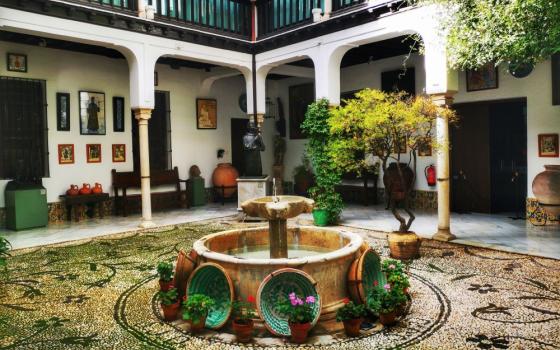
Cardinal Dario Castrillon Hoyos, the former Vatican official who sent a letter in 2001 praising a French bishop for sheltering an abusive priest, had earlier intervened, against the wishes of a U.S. bishop, on behalf of an American abuser priest, according to documents that were part of a lawsuit.
Castrillon pressured Bishop Manuel Moreno, who was bishop of Tucson, Ariz., from 1982-2003, to allow a priest sex abuser to take a pension and work outside the diocese, despite allegations that would later jolt the diocese and cost millions to resolve. Fr Robert Trupia "sexually abused dozens of minor boys" before he was defrocked in 2004, according to documents in the civil case.
The litigation surrounding the case opens a rare window on the operation of the Vatican legal system.
Castrillon, who was named a cardinal by Pope John Paul II in 1998, sparked a new episode in the Vatican crisis last week when his 2001 letter to a French bishop surfaced, praising him for sheltering a predator. Moreover, Castrillon implicated the late John Paul II in that decision. "After consulting the pope ... I wrote a letter to the bishop congratulating him as a model of a father who does not hand over his sons," Castrillon was quoted in the daily La Verdad as telling a religious conference in Spain on April 16.
Four years before that letter, Castrillon, who was then head of the Vatican's Congregation for the Clergy, challenged Moreno’s disciplinary action against Trupia, and threatened the bishop with possible financial damages if he did not allow the accused predator to maintain his priestly status and work elsewhere.
"I have never seen the direct intervention of a prefect of a Vatican congregation in a case like this," said Dominican Fr. Thomas P. Doyle, a canon lawyer who worked as expert witness for the plaintiff's attorney, Lynn Cadigan.
Castrillon was to have been the main celebrant of a solemn Traditional Latin high Mass slated for Saturday at the Basilica of the National Shrine of the Immaculate Conception in Washington. He agreed to step aside following objections from sex abuse survivors and others.
Although the cases against Trupia have been resolved and he has been removed from the priesthood, NCR recently received documents that were part of the litigation showing Castrillon’s role in the matter.
Castrillon, a multilingual Colombian, canon lawyer and forceful critic of liberation theology, manipulated the Vatican system for years, as the documents reveal. Among the duties of the Congregation for Clergy is overseeing cases in which priests seek recourse against putatively unfair treatment by a given bishop.
The letters between Castrillon and Moreno expose an intra-church drama in which a troubled bishop spent years trying to oust a pedophile, only to be thwarted by a powerful official whose star was rising inside the Roman Curia.
A problem from the start
Trupia had a history of ingratiating himself with powerful church officials. He was also a problem from the start.
Ordained in 1973 for the Tucson diocese, Trupia began molesting boys at his first parish in Yuma. In 1976 a lay brother, Ted Oswald, helped several families report Trupia to the bishop. Trupia transferred to Tucson. Oswald sent the complaints to Bishop Francis Green, who not only ignored them, but also sponsored Trupia, then in his 30s, for membership in the Equestrian Order of the Holy Sepulchre, a society of Catholic chivalry. Green also secured Trupia's honorary appointment as a Papal Chamberlain and made him a monsignor.
Green retired in 1982. The new bishop, Manuel Moreno, learned that a housekeeper had discovered Trupia in bed with a boy. Moreno let him off with a warning. Trupia meanwhile was spending weekends at his alma mater, St. John seminary, in the Los Angeles archdiocese. But the seminary declared him persona non grata in 1988 for making advances on a student. In 1989, Moreno allowed Trupia to go to Washington to study canon law at The Catholic University of America.
In 1992 Trupia became judicial vicar of Tucson, handling marriage annulments among other canonical duties, when the mother of a boy from Yuma wrote a letter to Archbishop Robert Sanchez of the Archdiocese of Santa Fe, N.M., the metropolitan see that includes Tucson, accusing Trupia of abusing her boy when he was 10.
Moreno and the diocesan chancellor confronted Trupia, who admitted the abuse and asked to be allowed to retire. Moreno suspended him and asked him to enter St Luke Institute in Maryland, a clergy psychiatric hospital that treats priests with psychological and sexual problems.
A ‘loose canon’
Trupia the canonist went into action.
Calling himself a "loose cannon" in a letter to Moreno, he threatened to reveal that he had had a sexual relationship with a bishop, now deceased, and that the two of them and a third priest had had sex with a drug addict who was, at the time, a teenager. In exchange for his silence, Trupia, then 42, proposed that he retire with a pension and preserve his priest status. On June 25, 1992, he wrote Moreno: "You have no right, either civilly or canonically or pastorally, to direct me … to seek [psychiatric] evaluation." Trupia filed an appeal with Congregation for Clergy, which in 1992 was headed by Cardinal Jose Sánchez as prefect. The congregation turned down the appeal but downgraded the bishop's order to an administrative leave, rather than suspension.
Trupia appealed to the Signatura, which is the Vatican's Supreme Court.
In the meantime, the Tucson diocese paid settlements to two of Trupia's victims. As he filed canonical appeals, Trupia refused to enter St. Luke. He was drawing his salary and otherwise free, though denied any recommendation as a priest elsewhere.
Moreno hired a canonist in Rome to represent his stance in the Vatican courts.
 "Castrillon knew that Trupia had been accused of sexually abusing young boys and that it posed a significant financial threat to the diocese," said Doyle in an April 19 phone interview. "Trupia was arguing that he should be allowed to retire early and continue ministering on a part-time basis -- with no accountability. His proposal was ridiculous."
"Castrillon knew that Trupia had been accused of sexually abusing young boys and that it posed a significant financial threat to the diocese," said Doyle in an April 19 phone interview. "Trupia was arguing that he should be allowed to retire early and continue ministering on a part-time basis -- with no accountability. His proposal was ridiculous."
Castrillon succeeded Sánchez as prefect of the Congregation for Clergy. Although the case was tied up in the Signatura. Castrillon asserted his own authority as prefect on Dec. 13, 1996, and wrote Moreno "to ask you to resolve this matter by means of a 'reasonable solution.'" Castrillon underlined a phrase for emphasis:
“We strongly urge Your Excellency to enter into meaningful dialogue with Monsignor Trupia regarding the terms of solution he has proposed. In so doing, Your Excellency would also be well advised … that the matter of damages is not outside of the purview of any subsequent decision which may be rendered." (Emphasis in the original.)
Ignoring the inference that the diocese might owe Trupia financial reparations for not agreeing to his proposal, Moreno replied to Castrillon that "we consider [Trupia's stance] damaging to the faithful as well as to his 'victims' of the past. … we cannot let Monsignor Trupia ‘loose’ if we do not know whether he is respectful and faithful to the priesthood."
On Oct. 31, 1997, Castrillon wrote Moreno to say that the congregation "has found in his [Trupia’s] favor ... Concerning damages arising from the imposition of an illegitimate decree, it is the mind of this Dicastery that Your Excellency is liable for these from 2 June 1996 onwards. It would appear best that this matter ... be resolved in an equitable fashion" -- meaning that Moreno's diocese should provide a financial retirement package and give Trupia an endorsement to do canon law consulting work.
Castrillon's position was significant at the time because of other settlements the Dallas diocese had made a few months earlier.
In the summer of 1997, the Dallas diocese lost a jury trial involving nine victims of a priest named Rudy Kos in which the jury added punitive damages for a $119 million verdict. The plaintiff attorneys subsequently agreed to a negotiated settlement of $21 million. "The trial caused a lot of talk that around the office" at the Congregation for Clergy, Christopher Kunze, a former priest who worked there in the late 1990s told NCR. "Cardinal Castrillon complained about lawyers making money."
Risks ‘not imaginary’
Moreno addressed that very issue in his letter back to Castrillon on Dec. 22, 1997: "I cannot take risks with the lives of others and the patrimony" -- meaning property and assets -- "of this diocese without [a psychiatric] evaluation of Msgr. Trupia that would indicate that he is no longer a threat."
The bishop continued:
"I am at a loss to deal with the finding of the Congregation concerning damages. I have paid Msgr. Trupia full salary plus his medical and car insurance at all times, as the Congregation was so informed. I have been given no details so that we can even defend what other damages may have arisen. Msgr. Trupia has resigned his office and has no right to it.
“I have deep respect for the works of the Congregation for the Clergy, however, I have appealed the decision to the Signatura in this matter."
Moreno never heard back from Castrillon.
As lawsuits mounted, Trupia, who received $1,475 in monthly pension from Tucson, and commuted from an apartment in a Washington, D.C., suburb to do consultant work as a canon lawyer for the diocese of Monterrey, Calif. Moreno had no role in that arrangement. Trupia had Castrillon's letters endorsing his side of the dispute as a strange sort of bona fide.
In 2001, Yuma police briefly imprisoned Trupia on charges of child molestation from years past; however he was soon freed because of statute of limitations. The Monterrey diocese at that point discontinued his services.
In 2002, the Tucson diocese and its insurance carriers agreed to a $14 million settlement with victims represented by attorney Lynn Cadigan.
Support independent Catholic journalism. |
Castrillon in a press conference at the Vatican in spring 2002 said that the abuse crisis stemmed from "pan sexuality and sexual licentiousness" in America. He defended church laws that required dealing “with internal matters in an internal way.” Faulting a "culture of suspicion" that he said had arisen, he stated: "The church has never ignored the problem of sexual abuse, above all among its sacred ministers, even before it was on the front pages."
At that very time, Moreno was pushing for sanctions against Trupia, who was still a priest. In 2003 Moreno appealed to Cardinal Joseph Ratzinger, whose office had consolidated the responsibility on such cases. Things took a swifter turn despite Trupia's continued appeals on technicalities of canon law.
His 12-year odyssey in the Vatican courts ended Aug. 7, 2004 when the Tuscon diocese announced that Trupia had been involuntarily laicized by the Vatican.
[NCR contributor Jason Berry is the author of Lead Us Not into Temptation and coauthor, with the late Gerald Renner, of Vows of Silence . Berry's film documentary "Vows of Silence" explores the saga of the Vatican and Maciel. www.JasonBerryAuthor.com An investigative grant from The Investigative Fund at The Nation Institute supported research for this article.]





